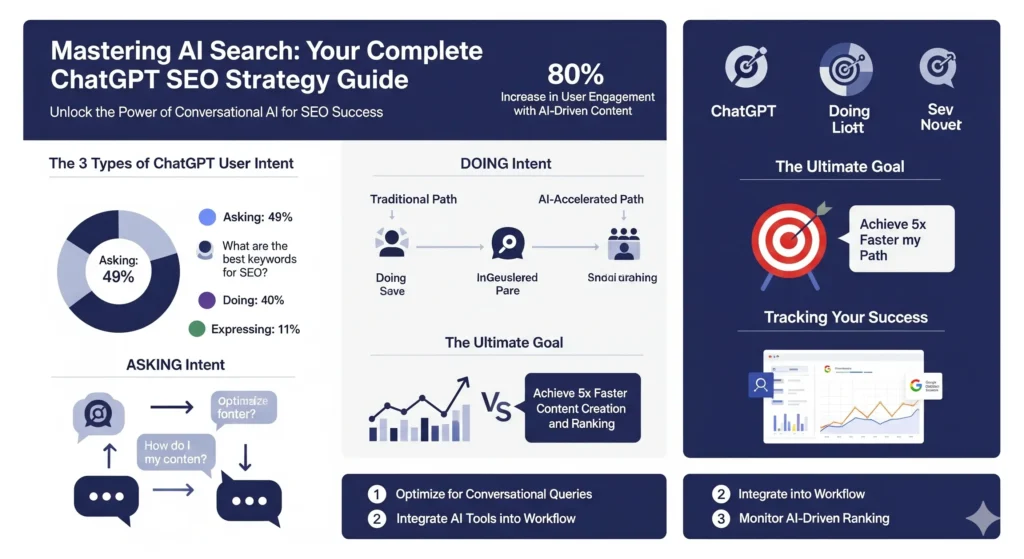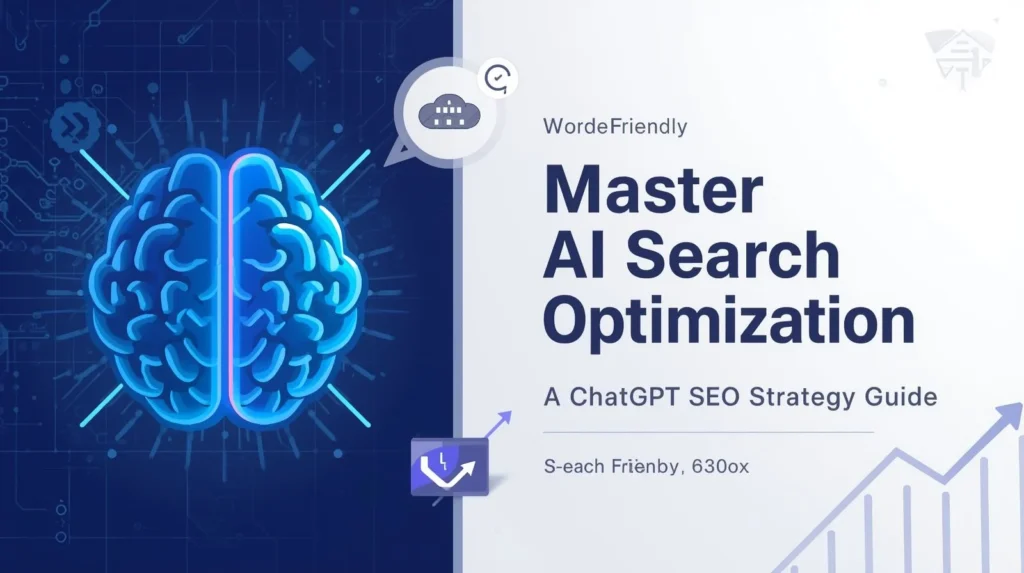Imagine typing a quick question into ChatGPT and getting a full rundown on the best tools for your job, complete with brand names and comparisons. That’s the power of AI search today. ChatGPT’s new paper reveals how over 700 million weekly active users interact with the platform, giving us a clear view of daily habits. This info helps SEOs and marketers boost brand visibility in AI responses, paving the way for better AI search optimization.
Grasping user intent in tools like ChatGPT matters more than ever. It drives brand awareness and shapes how you rank in AI-generated answers. In this post, we’ll break down key data from the paper and share steps to place your brand front and center. You’ll learn to spot valuable queries and track your progress.
We’ll dive into the three main user intents ChatGPT tracks: asking, doing, and expressing. Each offers chances to influence searches and sales. By focusing on the right ones, you can turn AI insights into real SEO wins.
Unpacking ChatGPT User Intent: The “Asking” Imperative
Asking queries make up 49% of ChatGPT’s activity. They often seek info or comparisons that can highlight brands. For SEO, these stand out because they push the AI to pull fresh data, not just rely on old training.
Identifying High-Value “Asking” Queries
High-value asking queries trigger retrieval from outside sources. This means ChatGPT grabs current info to build accurate replies. Brands shine here since the AI lists options based on web data.
Informational questions pose risks. If ChatGPT knows the answer from its base knowledge, it skips retrieval and cites nothing. Your brand won’t appear, so traffic stays low. Steer clear of basic facts like “What is SEO?” Instead, target fresh or complex asks that demand updates.
Think of it like fishing: cast your line where the big catches swim. Queries needing real-time pulls are those spots. They help your site rank in AI overviews, boosting overall search presence.

Actionable “Asking” Query Examples
Spot commercial asking queries to get your brand noticed. These often compare products or seek top picks. They fit perfectly into AI search optimization by naming competitors and winners.
Take this one: “Who are the best SEO content optimization tools for agencies? Rank by price and features.” The AI will list tools, links, and pros. Your brand could top the list if your content ranks well in searches.
Another strong example: “What are the best alternatives to Brand A?” Or “Compare Brand A vs. Brand B vs. Brand C.” These force mentions of rivals. Track them to ensure your name pops up often. Why ignore them? You can’t improve what you don’t measure.
Use these to audit your strategy. Search them in ChatGPT weekly. Note where your brand lands, then tweak site content to climb higher.
Leveraging Google Search Console for “Asking” Intent
Google Search Console uncovers asking queries your site already handles. It shows what users type to find you. Filter for patterns that match AI asks to spot gaps.
Try regex filters in the queries report. Enter something like “best (tool|software|alternative) for (agency|business)”. Hit apply, then sort by position. You’ll see low-ranking asks ripe for fixes.
Analyze results to guide content. For a query like “best SEO tools ranked by ease,” check top pages. Add a section to your guide or make a new video. Post on YouTube or LinkedIn to widen reach.
Don’t build thin pages for every query. Weave them into strong assets. If a topic fits your main guide, slip in details. This keeps content thick and useful. Aim for platforms Google uses in retrieval, like trusted sites and videos.
The “Doing” Intent: Navigating the Compressed Buyer Journey
Doing queries account for 40% of ChatGPT use. Users turn to it for tasks like writing emails or simple code. While not always brand-focused, they speed up buying decisions in smart ways.
Understanding “Doing” Queries and Their Impact
Doing intents involve action, not just questions. People ask ChatGPT to help with real work, like drafting plans or troubleshooting. This shifts how brands enter the picture, often at key moments.
Traditional searches spread across days and sites. Now, one chat handles it all. You start broad, narrow down, and buy fast. It’s like squeezing a week-long shop into 30 minutes.
I once needed a plugin for a site issue. In one ChatGPT session, I went from problem to purchase. No hopping tabs—just quick steps to a solution. This compression changes SEO forever.
The Shift to Single-Session Buying Journeys
Buyer paths used to zigzag: awareness, research, then buy over multiple visits. AI chats pack it into one flow. You describe a snag, get ideas, and land on products swiftly.
In B2B, this might span hours; for B2C, minutes. Either way, it’s faster. ChatGPT guides from vague worries to specific needs without leaving the window.
Picture a SaaS launch. You ask about billing models first. Then drill into options for your setup. By the end, you’re eyeing tools with trials and prices. Brands win if they show up here.
Mapping the AI-Accelerated Sales Funnel
Start at problem awareness: “What pricing models do SaaS firms use?” ChatGPT lists basics like subscriptions or freemium. No brands yet—just education.
Next, add details: “For seat-based billing with trials, which platforms work best?” Now it gets specific. The AI pulls three to five options, with links and docs. This is your roadblock solver.
End with solutions: prices, features, setup guides. Money flows when recommendations hit. Early stages build context; later ones drive clicks. Optimize for those end queries to capture intent.
Brand Surfacing within “Doing” Intent
Doing queries don’t always name brands upfront. But at journey’s close, they do. When users hit a wall, like “platforms for seat-based billing,” AI suggests fixes.
Your brand surfaces if content answers that exact pain. High conversions follow. Focus on problem-solving pages that rank in retrieval sources.
Create guides for common tasks. For e-commerce, cover “setup for local inventory tools.” Link to your services. This pulls users from AI chats to your site.
The Ultimate Goal: Driving Branded Searches Through AI
AI visibility isn’t about instant sales. It’s about planting your name so users search you later. Branded queries on Google convert way better than random ones.
AI-Generated Responses as Brand Awareness Drivers
The real win from AI search is recall. When ChatGPT mentions your brand in a list, users remember it. They might not click right then, but the seed is planted.
AI and Google team up, not compete. About 95% of ChatGPT users also hit Google regularly. Visibility in one boosts the other. It’s a cycle that lifts both.
Treat AI like social media marketing. Post value on LinkedIn or X to spark branded looks. Same here: get named in responses to fuel direct searches.
From AI Mentions to Google Authority
A solid AI mention leads to branded Google searches. Users type your name after seeing it recommended. These queries show intent—they’re ready to buy.
Branded traffic converts high because it’s targeted. Skip chasing AI referrals alone. Track how often your name sparks Google visits instead.
Build authority with quality content. If AI pulls from your site, you’re golden. Aim for top spots in commercial asks to dominate both worlds.
Measuring Success: Beyond Direct Conversions
Don’t fixate on ChatGPT clicks. Direct traffic from AI is nice, but rare. Most buys happen via influenced paths, like a later Google search.
Look at the big picture: brand lift across platforms. Use analytics to spot referral spikes or branded query jumps. True ROI shows in sustained growth, not one-off hits.
Question your metrics. Are you tracking awareness or just sales? Shift to both for a full view. This mindset turns AI into a long-term ally.
Minimizing Focus: The “Expressing” Intent
Expressing queries fill just 11% of ChatGPT time. They’re creative outlets, not sales tools. Skip heavy investment here for SEO goals.
Defining “Expressing” Queries
These prompts seek fun or role-play. Users want the AI to act out scenarios or vent ideas. No facts or products involved—just expression.
For example: “Role-play as a tough CMO interviewing me about our SEO tool for 15 minutes.” It’s engaging, but zero commercial angle. ChatGPT dives in without pulling external data.
They’re like casual chats with a friend. Entertaining, sure, but they won’t drive business.
The Lack of Brand Implication
Brands rarely appear in expressing responses. The AI focuses on the role, not recommendations. No links, no comparisons—just dialogue.
Wasting time optimizing for these pulls from real opportunities. Stick to asks and dos for impact. Your resources go further on commercial intents.
If a client pushes this, explain the low ROI. Redirect to high-value areas like buyer journey tweaks.
Practical AI Search Tracking and Optimization Strategies
Track AI performance without big budgets. Free tools let you monitor mentions and spots. Start small, scale as you learn.
The “No-Code” Approach to AI Tracking
Build trackers with Looker Studio, Google Analytics, and Search Console. No paid software needed. Set up dashboards to log queries and results.
Pull data weekly: enter commercial asks in ChatGPT, note brand spots. Feed into sheets, then visualize in Looker. It’s hands-on but precise.
Many tools are just API skins—yours is custom. Learn the steps for accuracy. Can’t handle millions? Fine for most campaigns. Focus on key queries first.
Key Metrics for AI Search Performance
Track two basics: appearance and position. Simple yes/no for if your brand shows. Then, rank it—first, middle, or last?
Appearance is binary: do you appear? Zero or one. Position matters too—top spots build trust faster.
Add volume: how often in top queries? Tie to traffic changes in Analytics. These paint your AI SEO picture.
The Role of SEO Expertise in AI Search
Solid SEO basics boost AI visibility. Strong content ranks in retrieval, so ChatGPT favors it. It’s not identical, but close enough to matter.
Build E-E-A-T: experience, expertise, authority, trust. Answer queries deeply. This influences AI pulls naturally.
Prioritize fundamentals. Optimize pages for commercial long-tails like “best alternatives to [your tool].” Good SEO wins in both AI and Google.
Conclusion: Embracing the Future of AI-Powered Search
ChatGPT’s data spotlights asking and doing intents as prime for brand growth. They shape visibility and speed up buyer paths in AI chats. Expressing takes a back seat—focus elsewhere.
The big aim? Spark branded searches via AI mentions. This drives conversions better than direct links. Tools like Google Search Console help spot and fix gaps.
Track with free setups: check appearance and position in responses. Strong SEO foundations carry over to AI success. Adapt now to lead in this shift.
Ready to optimize? Audit your queries today. Use regex in Search Console, test in ChatGPT, and build content that answers real needs. Your brand’s AI edge starts here—grab it and watch searches soar.


